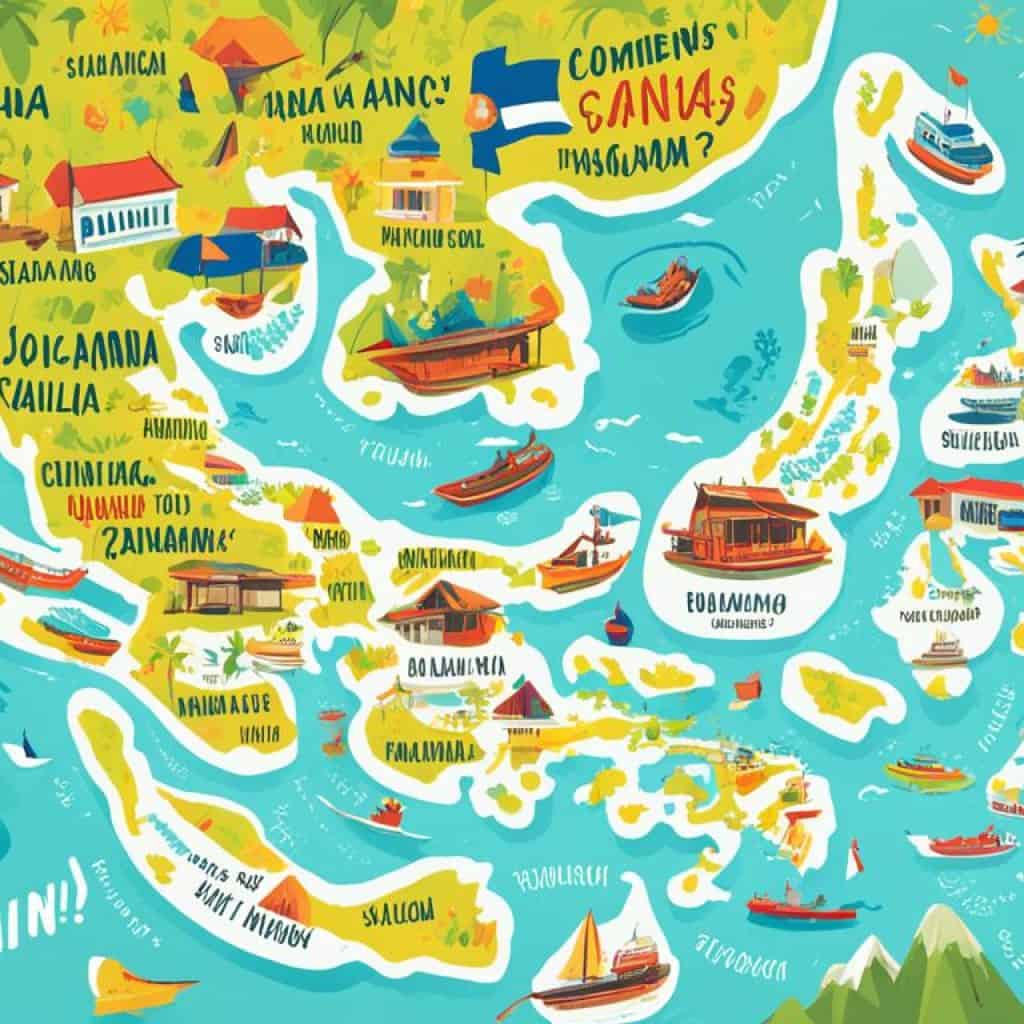Ever wanted to learn Filipino Tagalog? It’s not just a dialect but the Philippines’ national language. Over half the population speaks it. But, is it easy and effective to learn? Let’s find out together.
Key Takeaways:
- Filipino Tagalog is the national language of the Philippines and is spoken by over half of the population.
- Learning Tagalog is important for effective communication and cultural understanding in the Philippines.
- Tagalog has been influenced by Spanish and English, making it a fascinating language to explore.
- Online resources and interactive tools can help accelerate your Tagalog learning journey.
- By learning Tagalog, you can enhance your travel experiences, build stronger relationships, and open up new opportunities.
Importance of Learning Tagalog for Travel
While English is common in the Philippines, mastering Tagalog helps a lot, especially outside big cities. It’s tied closely to Filipino culture, key for really taking in the country’s traditions, customs, and interactions.
Understanding Taglog makes your Filipino culture exploration deeper. You can better connect with locals, creating meaningful interactions. This also widens your cultural insights.
“Learning Tagalog phrases and integrating them into your conversations can make a world of difference during your travels. It creates bridges between cultures and opens doors to authentic experiences.” – Local Travel Expert
Having a Tagalog-English dictionary improves your travel. It helps with translations, reading local menus, signs, and simple talks. Whether ordering food, haggling, or greeting, speaking Tagalog makes things smoother.
Learning Tagalog shows respect to Filipino culture, enriching your travels. You will communicate better and appreciate the culture more.
Benefits of Learning Tagalog for Travel:
- Enhanced cultural understanding
- Deeper connections with locals
- Authentic travel experiences
- Improved communication in non-English speaking regions
- Ability to navigate local menus and signs
| English Phrase | Tagalog Translation |
|---|---|
| Hello! | Kumusta! |
| Thank you | Salamat po |
| How much is this? | Magkano ito? |
| Where is the restroom? | Saan ang banyo? |
| What is your name? | Ano ang pangalan mo? |
Start learning Tagalog and immerse in the vivid Filipino culture. By knowing the local language, you’ll uncover the real spirit of the culture. Plus, you’ll make unforgettable memories and deep connections.
Historical Influences on Tagalog
The Philippines has a rich history that has shaped Tagalog. This includes occupation by Spain and the United States’ influence. Spanish rule added many words to Tagalog. Later, English became the official language with the United States’ takeover.
Understanding this history helps learners grasp Tagalog better. By knowing about the Spanish and American impacts, learners can appreciate Tagalog’s vocabulary and structure.
Learners can understand Tagalog better by exploring its history. Resources like tagalog phrases and dictionaries are helpful. They provide insight into the language’s unique mix of influences.
“Spanish influence has indeed left its mark on Tagalog vocabulary, making connections between the two languages apparent to those familiar with both.”
Resources like tagalog dictionaries are vital for learning. They help learners discover the history behind words and phrases. This exploration reveals connections to Spanish and English, adding depth to their understanding.
Using diverse learning tools supports learners. This includes tagalog phrases, dictionaries, and more. They help learners understand Tagalog’s history and its influences.
| Spanish Influences on Tagalog | Spanish Words in Tagalog |
|---|---|
| Food and Cuisine | Adobo, Paella, Lechon |
| Religion | Simbahan (Church), Kristiyano (Christian) |
| Family and Relationships | Anak (Child), Kapatid (Sibling) |
| Language and Communication | Kumusta (How are you?), Salamat (Thank you) |
Learning Tagalog Fast and Pronunciation
Learning to speak Tagalog fluently is easier than many think, even for new learners. This language belongs to the Austronesian family and uses the Latin alphabet. So, the good news is, every letter is pronounced, no silent letters. With the correct tools and practicing often, you can quickly improve your Tagalog speaking skills.
“Learning a new language is like entering a different world, and Tagalog is your passport to the vibrant culture of the Philippines.”
Learning Tagalog online is convenient and works with your schedule. Audio courses are great because they let you hear how native speakers talk. Practicing along helps you speak more naturally. Talking with others in practice sessions improves your skills in real conversations.
Another great tip is to do pronunciation exercises with native speakers. They can give you feedback right away. This helps fix mistakes and polish how you speak.
Key Benefits of Online Tagalog Learning
- Access to interactive audio lessons and practice materials
- Opportunities to engage in conversational practice with both learners and native speakers
- Options for individualized learning based on your proficiency level
- Convenience of learning from anywhere and at any time
- Availability of online communities and language exchange platforms
Make the most of technology to improve your Tagalog fast. Putting in regular time and work will raise your level. You’ll be better at Tagalog, ready for cultural exchanges, making new friends, and travel adventures.
Common Tagalog Phrases for Travel
Visiting the Philippines? Learning common Tagalog phrases is a must. It helps you talk to locals and understand their culture. Whether you’re in lively cities or peaceful islands, these phrases are your key. They ease day-to-day talks, from saying hello to asking where to eat. Mastering them makes your trip better.
Greetings and Basic Phrases
- Kumusta? – How are you?
- Salamat. – Thank you.
- Paalam. – Goodbye.
- Magandang umaga. – Good morning.
- Magandang tanghali. – Good noon.
- Magandang hapon. – Good afternoon.
- Magandang gabi. – Good evening.
Introductions and Formalities
- Ako si [Your Name]. – I am [Your Name].
- Paumanhin po… – Excuse me (formal).
- Puwede po ba akong humingi ng tulong? – May I ask for help? (formal)
- Pasensya na po. – I’m sorry (formal).
Ordering Food and Drinks
- Pabili po ng… – Please buy me…
- Kainan po dito? – Is there a place to eat here? (formal)
- Magkano ito? – How much is this?
- Isa pong kape, salamat. – One coffee, please (formal).
Asking for Directions
- Pwede po malaman kung paano pumunta sa… – Can you tell me how to get to…
- Saan po ang Comfort Room? – Where is the Comfort Room? (formal)
- Puwede po ba kayong maging tour guide ko? – Can you be my tour guide? (formal)
- Totoong malapit ba ito? – Is it really close? (formal)
“Ang language truly reflects the heart and soul of a culture. By learning Tagalog phrases, you are embracing the Filipino way of life and building connections that go beyond words.”

Deep dive into Filipino culture by practicing these phrases. Use them for greetings, at eateries, or to find your way. Knowing these expressions deepens your travel experience. It helps you connect with Filipinos. Start learning and explore the beauty of Tagalog!
Reasons to Learn Tagalog Fast
Learning Tagalog quickly offers benefits for your language skills and understanding of culture. Here are key reasons to start your journey with the Tagalog language:
1. Better Communication with Locals
Knowing Tagalog helps you talk better with locals in the Philippines. You can chat, ask for directions, or dive deep into the local culture. Having Tagalog phrases ready can make a big difference.
2. Job Opportunities
Tagalog can lead to new career paths, especially with Filipino communities. Employers often look for people who can speak Tagalog. It shows you’re culturally aware and can reach a wider audience.
3. Deeper Cultural Understanding
Learning Tagalog opens up the Filipino culture to you. The language reflects Filipino traditions and history. It lets you connect with locals and understand the Filipino soul more deeply.
4. Stronger Relationships
Speaking Tagalog helps build stronger bonds with native speakers. It’s a show of respect for their language and culture. This foundation leads to deeper and more meaningful connections.
5. Enhanced Travel Experiences
Knowing Tagalog makes travelling in the Philippines better. It lets you experience the culture more authentically. You get to know local secrets and adventures.
6. Utilize Online Resources
With online resources, learning Tagalog is easier than ever. You can learn at your own speed and practice anytime. These tools speed up your learning journey. Just a few clicks open up many learning opportunities.
These reasons show why learning Tagalog quickly is rewarding and enriching. It opens up new worlds and opportunities.
Tagalog vs. Filipino: Understanding the Difference
Many people get mixed up between Tagalog and Filipino, thinking they are the same. Yet, they differ greatly. Tagalog is an old language with a history and words from Spanish. Filipino is a standard version of Tagalog that brings in words from other Philippine languages and abroad.
To grasp the Philippines’ language diversity, we must spot the differences between Tagalog and Filipino. Tagalog, mainly spoken in Manila, is seen as a dialect of Filipino. Filipino, on the contrary, is the national language used across the Philippines.
Tagalog is heavily influenced by Spanish, but Filipino includes terms from regional dialects and English. This shows the Philippines’ rich mix of cultures. The difference between Tagalog and Filipino makes sure the language mirrors the varied cultures and languages of Filipinos.
Tagalog Phrases in Everyday Conversation
Tagalog phrases are often used daily by Filipinos. Knowing some basic phrases helps you blend in and understand the culture better.
“Magandang umaga po.” – Good morning.
“Salamat po.” – Thank you.
“Paalam po.” – Goodbye.
These phrases are handy for greetings, thanks, or farewells. By learning them, you improve your communication and bond with Filipinos.
Comparison of Tagalog and Filipino
| Tagalog | Filipino |
|---|---|
| Archaic language | Standardized form of Tagalog |
| Derived from Spanish vocabulary | Incorporates other Philippine languages and foreign loan words |
| Generally considered a dialect of Filipino | National language of the Philippines |
| Mainly spoken in the Manila region | Spoken throughout the Philippines |
The table above clearly shows how Tagalog and Filipino differ. Knowing these differences allows us to cherish the Philippines’ unique language heritage.
Diving into Tagalog and understanding its differences from Filipino lets us value the Philippines’ rich culture even more.
Tagalog’s Global Reach
Tagalog, the national language of the Philippines, is spoken around the globe. It has over 40 million speakers in places like the United States, Australia, New Zealand, and parts of Asia. This wide presence of Tagalog fosters cultural understanding, business opportunities, and personal ties.
Tagalog’s Worldwide Impact
“Learning Tagalog phrases and using a tagalog dictionary can foster meaningful connections with the Filipino community in diverse cultural contexts.”– Language Learning Magazine
The widespread use of Tagalog around the world helps build connections in areas such as tourism and trade. Through Tagalog, people can explore new experiences and form bonds with Filipino communities everywhere.
The Benefits of Tagalog’s Global Presence
Knowing Tagalog can improve cross-cultural talks. It lets people dive into various cultures, enjoy diversity, and make new friends. Knowledge of Tagalog is useful for business, travel, or meeting Filipino people in your area.
| Benefits | Examples |
|---|---|
| Cultural Exchange | Participate in traditional Filipino celebrations and customs. |
| Business Partnerships | Expand your network and collaborate with Filipino entrepreneurs. |
| Enhanced Travel Experiences | Navigate local communities with ease and connect on a deeper level. |
| Personal Connections | Forge lifelong friendships with individuals from different backgrounds. |
Learning Tagalog can help broaden your view of the world and deepen your appreciation of Filipino culture.
Technology and Tagalog Learning
Technology has changed the way we learn Tagalog, making it easy and accessible. Online tools offer comprehensive lessons, pronunciation help, and interactive activities. With these Filipino learning resources, you can dive into Tagalog phrases and talks without leaving your house.
Language learning apps and podcasts make it easy to practice Tagalog anywhere. A few taps on your smartphone let you into a world of audio lessons and vocabulary games. These Tagalog learning apps are a handy way to better your skills anytime.
Technology also boosts your learning with virtual language exchange programs. These services link you with native Tagalog speakers for real-time practice and feedback. It’s now simpler to find a language exchange buddy who can help with your accent and words.
Quoting Reference:
“Learning a new language can feel overwhelming, but technology makes it easier and fun. Online sites and apps offer many Filipino learning resources for all kinds of learners. Whether you like interactive or audio lessons, tech has your back.”
But, you must mix technology use with dedication to truly learn Tagalog. While apps and websites are great, they can’t replace the need for regular practice. It’s important to talk in Tagalog, read, and find real-life chances to use the language.
Using technology as a help in learning Tagalog and mixing it with other methods can boost your skills. Finding the right balance for you is key. Enjoy learning about the beauty and richness of the Filipino language!
Starting Point for Learning Tagalog
Choosing the right starting point is key when you begin learning Tagalog. Watching Tagalog movies and listening to podcasts helps you get used to the language’s sound and sentence structure. Reading Tagalog literature, like poetry and short stories, teaches you about the culture. Using dictionaries and language resources helps you learn new words and understand grammar better.
Movies and podcasts in Tagalog give you a real feel for the language. Watching movies with subtitles or listening to podcasts with transcripts can improve your listening and understanding. These also expose you to common phrases and expressions.
Watching Tagalog movies and listening to podcasts is fun and educational. It lets you immerse in the Philippines’ culture and stories while improving your language skills.
Reading Tagalog literature shows the language’s beauty and depth. Through stories and poems, you learn about Filipino culture, values, and traditions. You also learn new words and grammar in an interesting way. You can find Tagalog literature online, in e-books, or local bookstores.
Online dictionaries and learning resources are key for Tagalog learners. They explain words, grammar, and sentence structure in detail. They also have audio pronunciations, examples, and exercises for practice. **Tagalog.com**, FilipinoPod101, and FluentU are great online platforms for learning Tagalog.
Vocabulary Expansion through Contextual Learning
Expanding your vocabulary is important for mastering Tagalog. Learning words in context is an effective method. It helps you remember words and how they are used.
Contextual learning makes remembering and using words and phrases easier. For instance, studying food words lets you talk about eating confidently. Learning related words and phrases together helps a lot.
An organized way to expand your vocabulary is by making themed word lists. Group words by topics like colors, family, travel, or jobs. This helps you build a rich vocabulary you can use in different situations.
The Importance of Practice and Consistency
Consistent practice is what will make you fluent in Tagalog. Talk with native speakers, find language exchange partners, or join online communities to practice. Watching movies, reading, and using resources are great, but practice makes perfect.
Practice writing in Tagalog to improve your grammar and vocabulary. Writing phrases, sentences, and paragraphs helps solidify your language skills. Online forums and social media are great places to get feedback and meet other learners.
Tagalog Learning Resources
| Resource | Description |
|---|---|
| Tagalog.com | An online platform offering comprehensive lessons, vocabulary lists, and language exercises for Tagalog learners. It provides audio recordings and interactive activities to enhance language skills. |
| FilipinoPod101 | A podcast-based learning platform that offers audio lessons, vocabulary expansion, and cultural insights. It covers various levels, from beginner to advanced. |
| FluentU | Uses authentic Tagalog videos, such as movie clips, music videos, and news, to teach the language in context. It provides interactive subtitles, vocabulary lists, and quizzes. |
Learning Tagalog is an adventure that needs your commitment, practice, and the right resources. Begin with movies, literature, dictionaries, and online tools. This way, you’ll build a strong basis in Tagalog and work your way to fluency.
Grammar and Sentence Structure in Tagalog
Learning Filipino Tagalog means getting the hang of its grammar and sentence structure. It’s a bit like English because it uses a subject-verb-object pattern. But, Tagalog has its own unique grammar points.
Tagalog’s special trick is how it uses root words plus affixes. This creates new words and meanings. For anyone learning, knowing how affixes work is key to making correct Tagalog sentences.
To get better at Tagalog, practice speaking and writing it. Talking with native speakers and getting into real-life situations improves your skills. It’s the best way to use what you’ve learned.
The Subject-Verb-Object Pattern
The subject-verb-object setup in Tagalog is quite similar to English. First comes the subject, then the verb, and finally the object.
Example:
English: The cat eats the fish.
Tagalog: Kumakain ng isda ang pusa.
In Tagalog, you can mix up the word order to show emphasis or a different meaning. Still, the subject-verb-object pattern is a common way to chat.
Affixation and Word Modification
Affixation is a big deal in Tagalog grammar. It’s about adding to root words to change their meaning or show tense, mood, and more.
Affixes can tweak verbs, nouns, and adjectives in Tagalog. Learning these affixes helps you make sentences that are accurate and convey what you mean.
Example:
Root Word: Basa (to read)
Verb Form: Magbasa (to read)
Noun Form: Pagbasa (reading)
Adjective Form: Basahin (readable)
Building Proficiency in Tagalog
Getting good at Tagalog takes practice and being exposed to the language. Here’s how to sharpen your grammar and sentence making:
- Talk with native speakers to work on your sentence creation and grammar.
- Use online tools for exercises and lessons in Tagalog grammar and structuring.
- Find language buddies or join exchange programs for real Tagalog conversations.
- Dive into Filipino culture and media to see Tagalog in action.
Keep learning about Tagalog’s grammar and sentences. Use what you know in daily situations. This will help you speak fluently and clearly.
Vocabulary Expansion in Tagalog
Building a strong vocabulary is key when learning Tagalog. Adding new words from thematic word lists helps express yourself better.
Knowing synonyms and antonyms enriches your language skills. It lets you communicate in Tagalog with more depth. By knowing more words, you share your thoughts better.
A good way to learn is by making word lists for specific themes. You might make a list for food, travel, or everyday activities. These lists help you learn words that are often used.
Also, learning synonyms and antonyms makes your vocabulary wider. Synonyms mean similar things, and antonyms mean the opposite. Knowing these gives you more ways to express yourself and understand Tagalog better.
Example Thematic Word List: Numbers
| English | Tagalog |
|---|---|
| One | Isa |
| Two | Dalawa |
| Three | Tatlo |
| Four | Apat |
| Five | Limang |
| Six | Anim |
| Seven | Pito |
| Eight | Walo |
| Nine | Siyam |
| Ten | Sampu |
Learning more Tagalog words is a continuous journey. It involves regular practice and using the language often. There are many online resources for learning Filipino. These include courses, apps, and interactive exercises for better vocabulary.
Remember, a diverse vocabulary is crucial for fluency. Keep adding new words to your list. This will improve your Tagalog and help you connect with Filipino culture.
Continue to the next section to discover tips for active language acquisition in Tagalog.
Tips for Active Language Acquisition
Active language acquisition means learning Tagalog by using it in everyday situations. You learn faster by talking with native speakers, practicing with partners, and joining language immersion programs. Using active methods along with online tools and courses helps improve your skills quickly.
Engage in Meaningful Conversations
Talking with native speakers is a great way to learn Tagalog. It puts your skills to use in real situations. This helps you get better at speaking and understanding the language.
Practice with Language Exchange Partners
Learning with someone who is also studying Tagalog is very helpful. It allows for real conversations, which boosts your ability to listen and speak.
Participate in Language Immersion Programs
Immersion programs are a deep dive into Tagalog. You live in a Tagalog-speaking area, take classes, and do cultural activities. This approach helps you learn quickly and understand Filipino culture better.
Utilize Online Resources
Online tools are great for learning Tagalog at your own pace. Websites, apps, and online courses make learning fun and engaging. They offer lessons, exercises, and help with pronunciation and vocabulary.
Take Structured Language Courses
Courses in Tagalog provide structured learning. They cover everything from grammar to conversation. Enrolling in these courses builds a strong foundation for your language skills.
Being active in your language learning, like having conversations and using online resources, makes learning Tagalog faster. Embrace these methods, and see your skills grow.
| Tips for Active Language Acquisition |
|---|
| Engage in Meaningful Conversations |
| Practice with Language Exchange Partners |
| Participate in Language Immersion Programs |
| Utilize Online Resources |
| Take Structured Language Courses |
Benefits of Learning Tagalog
Learning Tagalog has many advantages like better communication skills, cultural insights, more job opportunities, and stronger bonds with Filipinos. Knowing Tagalog helps you in both social and work situations. You get to have real talks with native speakers.
Learning Tagalog is more than just learning words. It’s about personal growth and experiencing a new culture. You get to know the Filipino traditions and customs deeply by diving into their language and culture.
Enhancing your communication is a big benefit of learning Tagalog. When you know how to use Tagalog phrases, you can talk well with the locals. This opens the door to new friendships and chances at work with Filipinos.

Learning Tagalog also means getting to know the Filipino way of life better. You learn hidden meanings in talks, books, songs, and films. This cultural dive makes the experience real and rich, leading to appreciation between cultures.
Being good at Tagalog can also help you in your career, especially where Filipino customers or coworkers are. It shows you value diversity and can relate to different people well. Your understanding of different cultures stands out.
There are many online tools for learning Filipino. These include lists of Tagalog words, grammar tips, and audio lessons. You can learn at your speed with courses, language exchange sites, or by studying alone. These tools help in your journey to learn Tagalog.
Overall, learning Tagalog offers more than just language skills. It leads to better communication, cultural knowledge, job prospects, and friendships with Filipinos. Start learning Tagalog and open up a new world of opportunities.
Conclusion
Learning Filipino Tagalog is both fun and rewarding. It can bring many benefits. By diving into the language and its culture, using online tools, and practicing often, you can become fluent in Tagalog. This journey can open up new chances for cultural experiences, closer ties with Filipinos, and more opportunities.
Becoming part of the Filipino Tagalog world is exciting. It’s great for travel, work, or connecting with Filipino culture. Learning Tagalog makes your experiences richer. So, why not start today? Begin your journey into the Filipino language and Tagalog dialect. See all the great things they offer.
Fluency in Filipino Tagalog is more than learning words. It’s about connecting with a vast culture, understanding different customs, and building deep relationships. Start your adventure now. Dive into the beautiful Filipino language.







Add comment